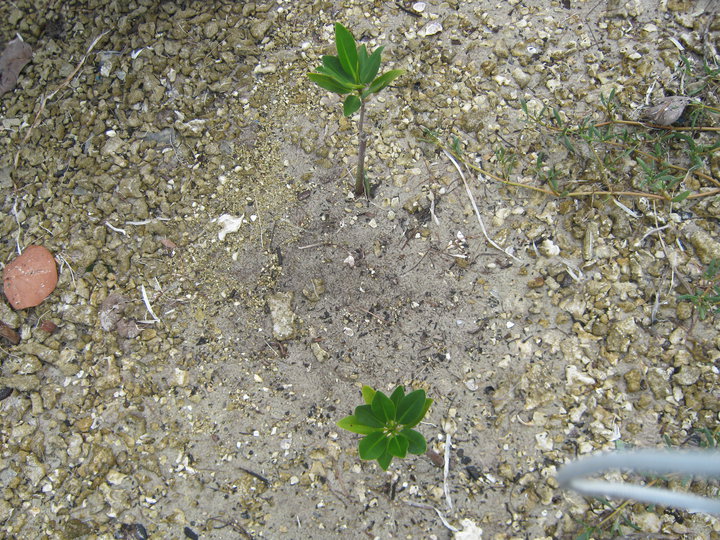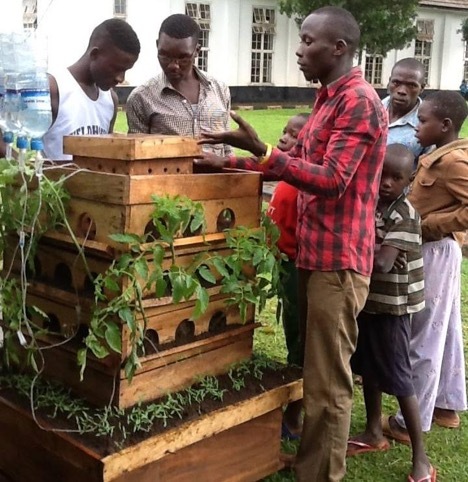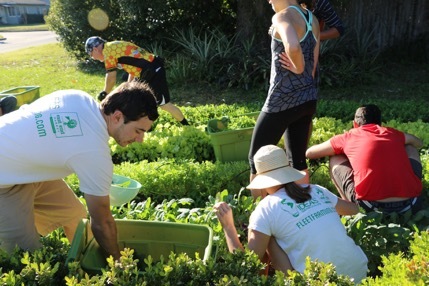To achieve the Global Goals for Sustainable Development (SDGs) by 2030, there needs to be considerable focus on how best practices from local action can be scaled to meet country level goals. For the last decade, IDEAS For Us (IDEAS) has built a presence on campuses and communities around the world to develop projects, fund local action, and scale solutions that address the socio-environmental challenges of specific populations.
We have refined this approach to help advance Sustainable Development Goal 17 by creating a micro-granting program that utilizes citizen-led, local action as a means of generating valuable statistically significant data to help guide the way for larger projects needed to achieve the remaining 16 SDGs worldwide.
The key to successful implementation of these action-oriented micro-grants derives from SDG 17 itself, what we call transcendental partnerships; synergies which transcend local communities, national boundaries, ideologies, transnational actors, and development sectors.
Such partnerships are the keystone of achieving the SDGs.
Our micro-granting program is called The Solutions Fund. It was developed in 2015 for the purpose of helping our grassroots network of volunteers, the majority of which are in the global South, advance sustainable development through local action.
To do this, The Solutions Fund allows individuals and institutions to apply for technical and financial support from IDEAS that aims to address one or many of the SDGs. We have seen a great potential to generate sustainable development data by fostering this program and it is our hope that we will continue to implement projects that can help bridge the data-gap between local action with country level and international targets and indicators for the SDGs.
There are many advantages to developing local action projects focused on the SDGs. Local projects often serve as pilot programs or ‘proof-of-concepts’ for larger, countrywide initiatives. Implementation costs at the local level tend to be significantly lower and small-scale projects present an opportunity to explore new partnerships, innovate new approaches, and uncover obstacles to be avoided. Local action also provides an opportunity to uncover additional key performance indicators that can contribute to a better understanding of what works and what does not.
Yet, local action has its share of obstacles and since 2015 we have studied variables that lead to either project failure or best practices not being adopted. We have identified three barriers that need to be focused on to foster local action in the SDGs: development, funding, and scaling.
CREATING IDEAS FOR ACTION
Ideas for action projects need to be developed into refined courses of implementation with clear goals, participants, and outcomes. We develop local action projects by bringing together community members to directly assist in the design phase of each project.
In the Photo: Reforestation effort in Nepal in 2016. IDEAS For Us leads a Hive session in Pokhara, Nepal where students spent hours developing an idea into an SDG focused project that has clear goals, metrics, and performance indicators. Photo Credit: IDEAS/Christopher Stampar
This is a crucial but largely overlooked matter in project planning. We strive to not be prescriptive in our guidance, but to learn from the local community their needs and approaches to addressing their own challenges.
In 2016, we hosted an interactive and interdisciplinary workshop called The Hive in Pokhara, Nepal. We brought together community leaders, elected student officials from three local colleges, students, and small business leaders to take part in a design thinking exercise. We identified key environmental issues in their community and grouped them into our framework of The Five Pillars of Sustainability.
Related article: “FOOD SYSTEMS: AT THE HEART OF SUSTAINABLE DEVELOPMENT”
This is meant to facilitate the participants understanding of the synergistic relationship between energy, water, food, waste, and ecology issues, as well as potential small scale projects that could develop from further exploration.
We then had each group focus on a different element of the project. Metrics and indicators, participants, budget, timeline, and processes were all considered and then openly discussed. Our direction helped to add value and shape a clear course of action to implementing the project.
What is most significant however, is the focus placed on designing a project that has metrics and indicators that gather data related to social, environmental, and economic impact. In this particular instance, we were able to design a tree planting project that increased local plant biodiversity on cleared cattle land, brought together students and community leaders as partners, and focused on giving a voice to women and girls as project leaders and citizen scientists collecting data.
This approach of developing projects that have social, environmental, and economic impacts helps ensure that data generated can help inform larger SDG focused actions in the future.
In the Photo: Mangrove Habitat Clean-Up in Manila, Philippines. Often the barrier to affording a small scale action project is considerably lower than a country wide effort. We have identified $1,000.00 USD as the ceiling many projects need to reach the pilot phase. Photo Credit: IDEAS /Christopher Stampar
Target 17.3 focuses on mobilizing additional financial resources for developing countries from a multitude of sources. Funding local action is the second key function of The Solutions Fund and to accomplish this we have developed a micro-granting program.
Our volunteers and members are able to apply to The Solutions Fund for up to $1,000.00 USD. We have chosen this amount because most requests for funding we have received over the last decade have been well below this amount. The barrier for an individual or fellow NGO to cross in order to take action is usually very low and $1,000.00 USD is sufficient for pilot projects, especially in the global South.
Applicants fill out a series of questions that help us to understand the issue they are trying to address, the stakeholders involved, and desired outcomes. From there, we utilize a committee of staff and subject matter experts to work with the applicant to refine their project as described above, while setting key performance indicators.
This facilitation is accomplished online using our website and social media to communicate (i.e. Facebook video chat, WhatsApp, and Skype). This use of technology directly contributes to Target 17.6 by increasing the communication of countries in the global South with those in the North.
 In the Photo: Vertical Microgardening. In December of 2015, IDEAS For Makerere University used a $1,000 Solutions Fund microgrant to design and build their own vertical microgardening units, which helps to improve food security and nutrition in dense urban areas while tackling climate change and working with a variety of partners for successful implementation and scaling. Photo Credit: IDEAS /Christopher Stampar
In the Photo: Vertical Microgardening. In December of 2015, IDEAS For Makerere University used a $1,000 Solutions Fund microgrant to design and build their own vertical microgardening units, which helps to improve food security and nutrition in dense urban areas while tackling climate change and working with a variety of partners for successful implementation and scaling. Photo Credit: IDEAS /Christopher Stampar
Once a project is ready for funding, a micro-grant is issued. This grant is not a loan and never needs to be repaid. Our aim is to directly provide funding capital that advances Target 17.7, by promoting the development, transfer, dissemination and diffusion of environmentally sound technologies to developing countries.
This is always done on favorable terms, including on concessional and preferential terms, as mutually agreed. This can include funding for a solar panel, urban farming supplies, seeds to begin a nursery, supplies to build aquaculture facilities, or supplies for habitat clean ups. Funding can also be issued to buy supplies for research and development and other project assets.
Because applicants can request funding for projects that address any one of the SDGs or a combination of SDGs, this further contributes to Target 17.9 by enhancing international grassroots support through our network. Additionally, if a project is being replicated, each team is connected to one another via social media to increase cooperation and solidarity between regions, countries, and continents.
When funding is received, the project can follow the work plan designed by our team and stakeholders. This work plan serves as a roadmap for action and helps to maintain accountability and adherence to the agreed timeline.
Some projects are one-off events that take a weekend to complete, such as a trash clean up, and others are long-term multiyear undertakings that require dozens of community partners and support.
The work plan also indicates what aspects of the project need to be measured. This helps those implementing the project to provide useable data that we can gain insight from to determine a project’s impact. As the project unfolds, we focus on how Target 17.16 can be enhanced to build multi-stakeholder partnerships and Target 17.17 can be scaled to create synergy between businesses, NGOs, and Government.
The final phase of The Solutions Fund process focuses on driving SDG 17’s Target 17.18 and 17.19.
It is our goal to take the projects we fund and judge their impact by analyzing the metrics and indicators we assigned them. Projects that show a favorable, positive impact at addressing a given SDG or target, are labeled “Solutions”.
In the Photo: Shallow Well Rehabilitation. In December of 2015, IDEAS partnered with the Water and Development Committee Somalia, who received a $1,000 Solutions Fund microgrant to rehabilitate a shallow well in Southwestern Somalia. This project showed how partnerships can transcend national boundaries and global challenges to directly address many interlinked SDGs such as SDG 1, 2, 3, 5, 6, 11, 12, 13, and 17. Photo Credit: IDEAS /Christopher Stampar
These solutions are then added to an interactive map of projects on our website under the tab Solutions. Our goals align with Target 17.18 to extend our capacity building support to developing countries by 2020.
We aim to significantly increase the availability of high quality, timely, and reliable data disaggregated by income, gender, age, race, ethnicity, migratory status, disability, geographic location and other characteristics relevant to our work.
These piloted solutions will be freely available to browse in an open network of solutions on our website. Our team can then provide further technical support to stakeholders wishing to scale those projects to address specific SDGs.
In the Photo: Fleet Farming achieves multiple SDGs. By turning lawns into farms and sharecropping with homeowners, Fleet Farming is able to generate a profit while reducing fertilizers and runoff, and teaching a community of volunteers how to farm organically. Photo Credit: IDEAS/Christopher Stampar
The primary goal of The Solutions Fund is to build a data set of hyper-local sustainable development action projects replicated around the world. This data will help directly address the final target of SDG 17, Target 17.19.
By 2030, as stated in the SDGs, we will have built on existing initiatives to develop measurements of progress on sustainable development that complement GDP as an indicator for growth, and support statistical capacity building in developing countries.
We have already seen this in our most popular solution yet, an urban farming initiative called Fleet Farming. This program has measurable environmental, social, and economic impacts for the community it serves and generates enough revenue to create employment opportunities for citizens.
By having data that contributes to an economic understanding of sustainable development in particular, we can determine what initiatives show potential for being scaled nationally or internationally and which initiatives are best left addressing the SGDs locally.
Local solutions to our greatest problems exist today, but we have to continue to bring down the barriers for collaboration and funding among individuals, governments, businesses, and grassroot partners if we are going to scale them globally for a greater and more lasting impact. But these solutions require new notions of partnerships and projects.
We must develop transcendental partnerships which congregate a wide variety of stakeholders and their best practices into successful actions on a global scale. We must also view our projects through a holistic lens, recognizing and embracing the interdependency of each SDG and how our initiatives focused on one particular goal helps to achieve all of our Global Goals.
The Solutions Fund is a method of achieving SDG 17 and it is our goal to build our portfolio of solutions to 300 projects by the end of 2021 and then help to advise our network of partners, including UN stakeholders, as to which best practices and projects can be scaled from the local level into the large scale campaigns needed to achieve the SDGs worldwide by 2030.
We firmly believe that nothing short of truly global cooperation driven by local action will ensure achievement of the Global Goals.
Recommended reading: “INTEGRATED APPROACH PROGRAMME ON FOSTERING SUSTAINABILITY AND RESILIENCE FOR FOOD SECURITY IN SUB-SAHARAN AFRICA LAUNCHED IN ADIDAS ABABA”
EDITOR’S NOTE: THE OPINIONS EXPRESSED HERE BY IMPAKTER.COM COLUMNISTS ARE THEIR OWN, NOT THOSE OF IMPAKTER.COM. FEATURED PHOTO CREDIT: IDEAS
Contributing Authors:
 Clayton Ferrara is the Executive Director and CEO of IDEAS For Us since 2014. He is the first American to be named a “Darwin Scholar” by the Field Studies Council in London for his achievements as a young naturalist under 30. He founded the Terra Firma Institute and is now serving as a found board member of the now United Nations accredited and international NGO, IDEAS For Us. In 2011 he was named a “Young Alum of significant distinction” by Rollins College and in 2014 he was voted onto the Emerging Leader’s Council of the National Wildlife Federation.
Clayton Ferrara is the Executive Director and CEO of IDEAS For Us since 2014. He is the first American to be named a “Darwin Scholar” by the Field Studies Council in London for his achievements as a young naturalist under 30. He founded the Terra Firma Institute and is now serving as a found board member of the now United Nations accredited and international NGO, IDEAS For Us. In 2011 he was named a “Young Alum of significant distinction” by Rollins College and in 2014 he was voted onto the Emerging Leader’s Council of the National Wildlife Federation.


















